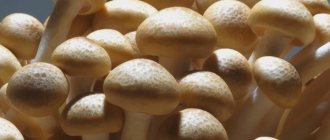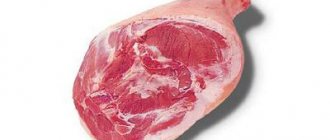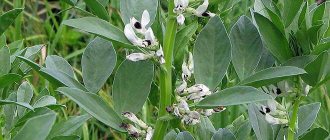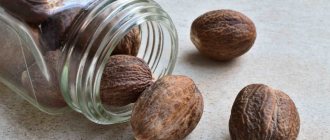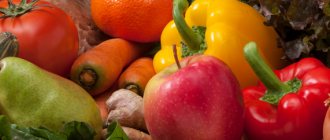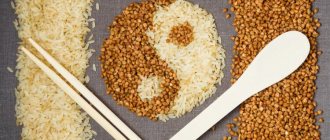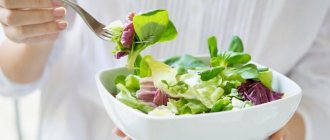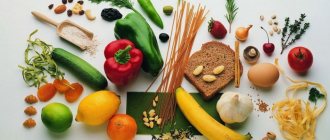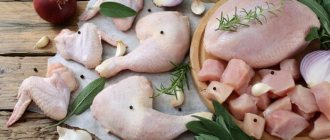Fresh mushrooms belong to the category of necessary products for vegetarian and dietary nutrition. Especially useful for those who are on a diet aimed at losing weight. They contain large quantities of plant protein. This product can easily replace meat dishes. The nutritional value of the diet will not change. Mushrooms are used as a main independent dish, and as an ingredient for salads, cold and hot appetizers, first and second courses. They can be included in the regular daily menu or consumed while fasting.
Harm of fresh mushrooms
Fresh mushrooms are a relatively harmless product, provided they are grown correctly. This product, like a washcloth, absorbs all harmful elements from the environment. Therefore, if you consume mushrooms that have grown in the wild, the risk of poisoning increases. Dishes made from mushrooms place additional stress on the organs of the digestive system, so it is not recommended to introduce them into the diet of children and people with gastrointestinal pathologies.
| Product | Kcal | Proteins, g | Fats, g | Angle, g | |
| Truffles | 24 | 3 | 0,5 | 2 | |
| Russula | 19 | 1,7 | 0,7 | 1,5 | |
| Boletus | 22 | 3,3 | 0,5 | 1,2 | |
| boletus | 20 | 2,1 | 0,8 | 1,2 | |
| Winter honey mushrooms, raw | 44 | 2,56 | 0,32 | 4,98 | |
| Grifola curly, raw | 31 | 1,94 | 0,19 | 6,97 | |
| Champignon mushrooms, raw | 27 | 2,5 | 0,1 | 3,52 | |
| Portobella mushrooms, raw | 26 | 2,5 | 0,2 | 3,57 | |
| Oyster mushroom, raw | 43 | 3,31 | 0,41 | 4,17 | |
| White mushroom, raw | 22 | 3,09 | 0,34 | 2,28 | |
| Auricularia ear-shaped, raw | 25 | 0,48 | 0,04 | 6,75 | |
| Honey mushrooms are spicy | 110 | 2 | 9,5 | 4,3 | |
| Matsutake mushroom | 28 | 3,9 | 0,7 | 1 | |
| Volushka mushrooms | 22 | 2,5 | 0,5 | 1,7 | |
| Serushka mushroom | 18,5 | 1,8 | 0,8 | 1,1 | |
| Ivyshen (Podvishennik) | 0 | 0 | 0 | 0 | |
| Common dubovik | 34 | 3,7 | 1,7 | 1,1 | |
| May mushroom | 19 | 1,7 | 0,7 | 1,5 | |
| White steppe mushroom (Eringi) | 43 | 3,31 | 0,41 | 4,17 | |
| Puff mushroom | 27 | 4,3 | 1 | 1 | |
| Semi-white mushroom | 34 | 3,7 | 1,7 | 1,1 | |
| Caesar mushroom | 19 | 1,7 | 0,7 | 1,5 | |
| Pluteus deer | 19 | 1,7 | 0,7 | 1,5 | |
| Yellow hedgehog | 30 | 3,7 | 1,7 | 1,1 | |
| Royal honey mushrooms (Golden scale) | 22 | 2,2 | 1,2 | 0,5 | |
| Mushroom cabbage (Sparassis curly) | 30 | 3,7 | 1,7 | 1,1 | |
| Petsitsa | 22,7 | 2,9 | 0,4 | 2 | |
| Hygrofor | 0 | 0 | 0 | 0 | |
| Winter honey fungus | 22 | 2,2 | 1,2 | 0,5 | |
| Wet purple | 19,2 | 0,9 | 0,4 | 3,2 | |
| Polish mushroom | 19 | 1,7 | 0,7 | 1,5 | |
| Ram mushroom | 30 | 3,7 | 1,7 | 1,1 | |
| Mushroom talker | 30 | 3,7 | 1,7 | 1,1 | |
| Wood mushroom muer | 10 | 10 | 0 | 2 | |
| Shimeji | 43 | 3,31 | 0,41 | 4,17 | |
| Row mushrooms | 19 | 1,7 | 0,7 | 1,5 | |
| Royal oyster mushroom | 43 | 3,31 | 0,41 | 4,17 | |
| Mushroom raincoat | 27 | 4,3 | 1 | 1 | |
| Portobello mushrooms | 22 | 2,11 | 0,35 | 2,57 | |
| Maitake mushroom | 31 | 1,94 | 0,19 | 4,27 | |
| Moon mushrooms | 30 | 4,8 | 0 | 2,4 | |
| Moss mushroom | 19 | 1,7 | 0,7 | 1,5 | |
| Enoki mushrooms | 42 | 2,7 | 0,41 | 0,22 | |
| Frozen mushrooms | 23 | 2,7 | 1 | 0,9 | |
| Hedgehog mushroom | 30 | 3,7 | 1,7 | 1,1 | |
| Birch chaga mushroom | 20 | 2,1 | 0,8 | 1,2 | |
| Nameko mushrooms | 22 | 2,2 | 1,2 | 0,5 | |
| Shiitake | 34 | 2,2 | 0,5 | 6,8 | |
| Chernushka | 9,1 | 1,5 | 0,3 | 0,1 | |
| Truffle | 24 | 3 | 0,5 | 2 | |
| Russula | 19 | 1,7 | 0,7 | 1,5 | |
| Morel | 22,7 | 2,9 | 0,4 | 2 | |
| Ryzhik | 22,3 | 1,9 | 0,8 | 2 | |
| Boletus | 22 | 3,3 | 0,5 | 1,2 | |
| boletus | 20 | 2,1 | 0,8 | 1,2 | |
| Champignon | 27 | 4,3 | 1 | 1 | |
| Honey mushrooms | 22 | 2,2 | 1,2 | 0,5 | |
| Butter | 19,2 | 0,9 | 0,4 | 3,2 | |
| Chanterelles | 19 | 1,5 | 1 | 1 | |
| Gruzd | 18,5 | 1,8 | 0,8 | 1,1 | |
| Porcini | 34 | 3,7 | 1,7 | 1,1 | |
| Oyster mushrooms | 35 | 3,34 | 0,44 | 6,43 | |
| Portabella mushrooms | 26 | 2,5 | 0,2 | 5,07 | |
| Mushrooms Sliced | 22 | 3,09 | 0,34 | 3,28 | |
| Mushrooms | 22 | 3,09 | 0,34 | 3,28 |
Chemical composition and nutritional value
The nutritional value of mushrooms directly depends on their age. Young plants are the most delicious and nutritious. They contain a high content of enzymes, vitamins, and mineral salts. Older plants retain less valuable nutrients and inorganic compounds. They are practically useless.
The chemical composition of mushrooms is truly unique. 90-95% is water, the rest is dry matter. Among them are the enzymes amylase, lipase, proteinase, and oxidoreductase. Edible plants also contain a lot of vitamins A, group B, C, D, PP, and also:
- 70% of dry matter is protein, which is why the plants are even called “forest meat.” This is an indispensable product for vegetarians.
- In terms of composition and amount of carbohydrates, mushrooms are close to plants. However, they still contain insulin, dextrin, and glycogen.
- In terms of vitamin content, mushrooms overtake liver and yeast, but many of them are destroyed during heat treatment. This primarily concerns carotene and vitamin C.
- The mineral content in edible plants is low, but sufficient to saturate the body with potassium, phosphorus, and iron. There is little calcium in these plants. But it will be well absorbed if you add sour cream or milk to the mushroom dish. Small amounts of iodine, copper, magnesium and zinc are also beneficial to the body, as these trace elements are involved in cellular metabolism.
The calorie content of mushrooms is low. It varies between 10-34 Kcal per 100 g of product. The most calories are in porcini mushrooms, the least in nigella mushrooms. The calorie content of dried and salted mushrooms is about 24 Kcal per 100 g of product.
Beneficial features
A large amount of protein makes the product no less healthy than poultry meat. The benefits of mushrooms are as follows:
- have antibacterial, anti-inflammatory and mild diuretic properties;
- normalize metabolic processes and promote slow, safe weight loss;
- stimulate tissue regeneration processes;
- relieve headaches, eliminate tinnitus;
- strengthen the vascular wall and reduce capillary permeability;
- prevent the deposition of cholesterol plaques and the development of atherosclerosis;
- improve myocardial functioning and prevent heart failure;
- normalize blood pressure numbers, prevent its sharp jumps;
- stimulate the production of digestive enzymes and bile;
- prevent stagnation in the gallbladder and the formation of cholesterol stones;
- strengthen bones and teeth;
- improve psycho-emotional state, prevent stress, depression, insomnia;
- improve memory and concentration;
- promote the removal of harmful compounds from the body;
- have a beneficial effect on joints with arthritis and arthrosis, relieve acute symptoms of pathology;
- relieve fatigue after prolonged exercise;
- help improve and maintain visual function;
- strengthen the immune system and prevent frequent viral and cold pathologies;
- replenish the deficiency of minerals and vitamins;
- slow down the growth and development of atypical cancer cells.
The product is useful for men because it prevents pathologies of the urinary system, stimulates sexual function and prevents its early decline, increases endurance and physical strength, and promotes muscle growth during intense sports.
For women, mushrooms are valuable because they normalize hormonal levels, the menstrual cycle, relieve unpleasant symptoms during menopause, help strengthen nails and strands and help maintain healthy skin. The antioxidant properties of the product help slow down the aging process and prevent the loss of elasticity of the epidermis.
Rules of use
The product is allowed to be used no more than 2 times a week. The amount is determined individually and depends on the person’s health status and possible complications after administration. For an adult, 100-150 g at a time is enough. During pregnancy and lactation, it is worth limiting this amount to 50 g per dose.
Children over 5 years old are allowed no more than 1 piece and no more than 2 times a week. Those who suffer from chronic digestive disorders should carefully monitor their condition when consuming the product and limit themselves to 40-50 g. Frequent use will certainly cause complications.
Boiled, stewed and dried mushrooms in moderate quantities will be the most useful. Salted, fried and pickled foods are best consumed rarely and in small portions. Currently, artificially cultivated mushrooms will become safer and healthier, especially for residents of large cities with a large number of industrial enterprises located nearby.
It is allowed to consume wild mushrooms collected by specialists in this field and in places remote from enterprises, highways and people’s homes. Only such a product is safe and healthy. In other cases, it is better to give preference to store-bought, artificially cultivated mushrooms.
Source: https://tonustela.net/calorific-value/vegetables/griby.html
Calorie content of mushrooms
So, let's start with porcini mushrooms, because they are frequent guests on our tables. Raw mushrooms have an energy value of thirty-five kilocalories per hundred grams. How many calories are in fried mushrooms? Much more - one hundred sixty-five. Boiled mushrooms bring us twenty-eight kilocalories, dried ones - two hundred and eighty-seven, and pickled ones - thirty. Frozen mushrooms have a calorie content of thirty-four kilocalories.
On a note! As you can see, dried mushrooms will be the most nutritious, and boiled mushrooms have the lowest energy value. But frozen mushrooms retain all their “usefulness”.
Now let’s figure out how many calories are in honey mushrooms:
- in raw - twenty-two kilocalories;
- fried with sour cream and onions - fifty;
- in pickled - eighteen;
- in boiled - twenty-six;
- in stews - forty-one;
- in frozen - ten.
On a note! How many calories are in salted mushrooms? A one-hundred-gram serving of these mushrooms contains twenty-two kilocalories.
The poles are considered relatively safe for health. How many calories are in oyster mushrooms? Raw mushrooms contain thirty-three kilocalories. Veshki fried in oil will contain seventy-six kilocalories, and boiled ones will contain thirty-five. Pickled oyster mushrooms “give” us one hundred and twenty-six kilocalories. How many calories are in stewed mushrooms? If we talk about veshki, then after stewing they contain twenty-nine kilocalories per one hundred gram serving.
Now let’s calculate the calorie content of chanterelles:
- fresh mushrooms bring us twenty kilocalories;
- fried - seventy-two;
- stewed - forty;
- boiled - thirty-two;
- salty - twenty.
On a note! How many calories are in pickled chanterelle mushrooms? Their energy value is eighteen kilocalories per hundred grams.
Calorie content of butter:
- raw mushrooms will contain nineteen kilocalories;
- fried - fifty;
- in frozen - forty;
- in boiled - twenty-one;
- in pickled - eighteen;
- in salted ones - nineteen.
On a note! Regardless of what kind of mushrooms you have, you can defrost them only once. If mushrooms are frozen again, they will lose all their “usefulness”.
Indicators of the energy value of camelina:
- raw mushrooms replenish our caloric reserves by seventeen units;
- fried - ninety-four kilocalories;
- boiled - twenty-two;
- pickled - seventeen;
- salty - seventeen.
And of course, we cannot help but pay attention to champignons, because these mushrooms are the most popular. They are tasty, they have a lot of “health benefits”. How many calories are in this product?
Calorie content of champignons:
- raw mushrooms will contain sixteen kilocalories;
- in boiled - fifteen;
- in those prepared with sour cream - forty-seven;
- in pickled - thirty-eight;
- in salted ones - seventeen.
Common types
According to scientists, there are more than 100 thousand species of mushrooms in nature. But not all varieties are eaten. There are several species that are common in Russia and are cultivated artificially.
White
Porcini mushroom, or boletus, is considered the most valuable type of mushroom because it has unique taste and beneficial properties. The species is quite large, has juicy flesh and grows up to 15 cm in length with a cap diameter of 20 cm. It grows under birch, oak, and pine trees.
A distinctive feature of this species will be the white flesh, which does not change when cut and emits a pleasant smell. You can distinguish boletus mushrooms from other similar mushrooms by the skin on the cap, which cannot be removed. The variety is ideal for stewing, frying, drying or pickling.
Chanterelles
Chanterelles are easy to distinguish from other species by their unique cap shape and orange color. Another feature will be the mucous surface, dense body and leg. Chanterelles grow up to 4 cm in height with a cap diameter of up to 5 cm. They are most often found in grassy areas with good access to sunlight. Chanterelles do not grow in the forest.
In cooking, a similar variety is used boiled, stewed, fried, pickled and salted.
Oyster mushrooms
A fairly common variety, growing in groups on the trunks of weakened or almost dried out trees. You can find them on birch, oak, pine, and rowan trees. With a stalk that reaches a maximum length of 5 cm, the mushroom has a cap up to 30 cm in diameter. The pulp is juicy, white or yellowish.
As the flesh ages, it loses its elasticity and juiciness. For this reason, only young oyster mushrooms are eaten. This species is suitable for various processing methods and is actively cultivated in many countries.
Honey mushrooms
Honey mushrooms are distributed everywhere and prefer to grow close to tree trunks or directly on them. Often found on dead trunks or stumps. They are small in size, the cap rarely reaches a diameter of more than 10 cm, and the leg grows no more than 8 cm. They resemble chanterelles in color.
Honey mushrooms are actively used in cooking for cooking, drying, stewing, pickling, and pickling. They have juicy pulp.
Champignon
Champignons are a popular type of mushroom, since they are not only actively collected by mushroom pickers, but also cultivated under artificial conditions. They have a dense stem no more than 5 cm long, a cap that reaches 20 cm in diameter. The flesh is white when cut, but darkens after a few minutes in the open air.
The mushroom exudes a pleasant aroma and tastes very juicy. Under natural conditions it grows in forests and open grassy areas. Suitable for any processing method and less likely than other types to cause indigestion, allergies, and other unpleasant symptoms.
Mushroom diet
The construction of a menu for weight loss is based on the option of processing forest gifts. Reviews say that people find them tasty only when fried. However, this method of preparation can increase the calorie content from the usual 18-40 calories to 300-400. The mushroom diet involves including mushroom dishes for breakfast and lunch, but not dinner. This is because these foods take time to digest, so nutritionists recommend not consuming them at night.
The menu can be varied. However, the amount of mushrooms should be limited to 100-200 grams per day. This limit will allow you to get the desired result - proteins in the required quantity, without overloading the digestive system. Popular dietary dishes are:
- light cream soups;
- mushroom casseroles;
- snacks and salads;
- salty options;
- cabbage rolls with mushroom filling;
- sauces.
- How to clear your lungs of nicotine
- Greek fish in the oven
- How to fry chicken in a frying pan deliciously
We marinate the mushrooms ourselves!
Today, many housewives have gotten used to pickling mushrooms on their own. This way you can be sure that they do not contain any preservatives or harmful components. We offer a universal recipe for all types of mushrooms. We will cook white ones, and you can take any others, especially since now you know their calorie content.
Ingredients:
- white mushrooms;
- allspice peas - ten pieces;
- clove inflorescences - two pieces;
- laurel leaves - three pieces;
- garlic - three cloves;
- purified water – one liter;
- salt - one table. spoon;
- granulated sugar - one table. spoon;
- vinegar - eight table. spoons
On a note! The number of mushrooms is not given. You can marinate as much as you like. The main thing is to prepare the marinade. The recipe contains ingredients per liter of marinade. It will not be difficult to calculate how much you will need.
Preparation:
- Let's look at our mushrooms. We throw away the wormy and leaky ones.
- We wash the mushrooms with a washcloth. We need to thoroughly clean sand, needles, leaves and other dirt from them.
- Let's cut the mushrooms.
- Place the mushrooms in a deep saucepan. Fill them with cold purified water and send them to boil.
- When the liquid comes to a boil, boil the mushrooms for five to six minutes.
- Then add water. Wash the mushrooms, then fill them with fresh water. Don't skip this step!
- We are waiting for the water to boil.
- On the middle level of the burner, boil the mushrooms for thirty minutes. Remove any foam that appears.
- We sterilize jars with a nominal volume of 500 ml or a liter. We will also sterilize the lids.
- Let's prepare the spices we need - granulated sugar, vinegar, laurel leaves, salt, peppercorns, clove inflorescences. Peel the garlic and chop it into slices.
- When the mushrooms have cooked for the required time, place them in a colander.
- Rinse the mushrooms with running water and leave for now.
- In the meantime, prepare the marinade mixture. Pour some water into the pan. Add granulated sugar and salt. Place laurel leaves, garlic cloves, clove inflorescences and peppercorns. Remember that the indicated amount of spices in the recipe is indicated for one liter of liquid.
- We are waiting for the marinade to boil. Add vinegar.
- After a couple of minutes, add the mushrooms to the marinade. They should boil for ten minutes.
- Remove the pan from the stove. While the mushrooms are hot, distribute them into jars. First add a laurel leaf, a clove inflorescence and a couple of peppercorns to each container.
- The jars must be filled to the very top.
- Pour the marinade mixture over the mushrooms. It should not reach the edge of the container a little.
- Roll up the lids. Let's turn the canned food upside down. Wrap the jars with a warm towel. When the mushrooms have cooled, you can move them to the pantry or cellar.
